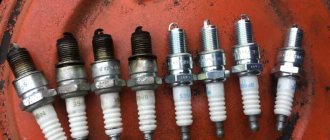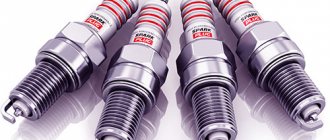The frequency of replacing spark plugs depends primarily on their type, or more precisely, on the material of the central electrode, as well as vehicle operating conditions, fuel quality, timeliness of oil changes, interruptions in engine operation and other external factors. According to the regulations, the service life of nickel spark plugs is 45,000 km, platinum – 80,000 km, iridium – 120,000 km. In practice, they fail 1.5–2 times faster. Average spark plug replacement interval – 30-60 thousand km.
Read our article about how often you need to change spark plugs, what signs indicate the need for immediate replacement, and what can happen if you don’t replace the spark plugs in time.
Why change spark plugs
Why change spark plugs, test on a bench: video
The function of the spark plug is to ignite the air-fuel mixture (FA) formed in the engine cylinders. During normal operation of all systems and the ideal condition of the parts, ignition is carried out at a strictly defined point in time using a spark discharge formed when the air gap between the central and side (side) electrodes breaks down. The energy released as a result sets the piston in motion, thus the operation of the motor directly depends on the serviceability of the part.
The need to replace spark plugs is due to the fact that they are subject to natural wear due to spark erosion, temperatures up to 2500 ℃ and pressure up to 50 bar in the combustion chamber, as well as exposure to aggressive substances contained in combustion products. As they are used, the electrodes become coated, become thinner and melt, which leads to an increase in the gap , a change in the shape and power of the discharge, up to a periodic or permanent absence of a spark.
With every 1000 km traveled, the gap between the electrodes of a classic nickel spark plug increases by 5–10 microns.
Deciphering error P0300 in the diagnostic program for Android: “Deciphering codes”
Ideally, spark plugs should be changed before obvious visual signs of wear and its characteristic symptoms appear:
- difficulty starting the engine;
- engine tripping;
- deterioration in acceleration dynamics;
- increased fuel consumption;
- the appearance of errors P0300-P0304, indicating misfires.
These symptoms can also appear when the spark disappears due to failed ignition coils, high-voltage wires, and in carburetor models - due to malfunctions and incorrect settings of the ignition distributor.
Compliance with the manufacturer's recommended replacement interval for spark plugs based on mileage, taking into account operating conditions, will allow you to avoid these problems and more severe consequences that result from malfunctions in the ignition system.
Advice for car owners
- If, after changing the spark plugs, little time has passed before the malfunction appears, then it is allowed to change only the damaged spark plug. But when a set of spark plugs has been used for a long time, then if it breaks, it is better to change everything.
- The section on candles must be carefully studied in the manual.
- If during checking the spark plugs it was discovered that they are like new and there are no interruptions in the operation of the car, then it is not forbidden to leave them for another couple of tens of thousands of kilometers.
What happens if you don't change the spark plugs in your car?
Failure to regularly replace spark plugs and ignore signs of wear can ultimately lead to more unpleasant consequences. The most serious problems that can be encountered if you do not change the spark plugs in your car on time are listed in the table below.
| Problem | Cause | Consequences |
| Knock ignition | An inconsistent, untimely or insufficiently powerful discharge leads to explosive ignition of the air-fuel mixture in the combustion chamber. | The shock wave has a destructive mechanical effect on the pistons, connecting rods and crankshaft. As a result of rising temperatures, valves, pistons and cylinder head gaskets may burn out. |
| Glow ignition | The fuel assembly is ignited not by a spark, but by hot electrodes. | An increase in pressure and temperature leads to burnout of parts of the cylinder-piston group and the formation of scoring on the cylinder walls. |
| TVS included in release | In the event of a misfire, the unburned air-fuel mixture, along with the exhaust gases, enters the exhaust manifold. | The toxicity of the exhaust increases, the wear of the catalytic converter accelerates, and if the fuel assembly in the exhaust ignites, it may be destroyed as a result of a shock wave (popping noises will be heard in the exhaust). |
| Candle destruction | Damage to electrodes and insulator as a result of critical mechanical or thermal wear during operation and during replacement. | Broken electrodes or insulator elements remaining in the combustion chamber cause damage to the piston and cylinder walls. |
| Significant increase in discharge voltage | An increase in resistance due to an increase in the gap between the electrodes or deposits on their surface, a breakdown of the insulation of the coil or tip of the explosive wire is possible. | Failure of the ignition coil and/or high-voltage wires. |
The problems listed in the table can also be encountered when installing spark plugs with an inappropriate heat rating or gap, or using low-quality or counterfeit parts.
When to change spark plugs
When is the best time to change spark plugs: video
How often you need to change spark plugs in a car depends on their design features and operating conditions of the car, the quality of the fuel and engine oil, as well as the condition of other components of the ignition system and the correctness of its settings. The most correct approach is to determine the frequency of replacement of spark plugs based on a combination of the following factors:
- central electrode material;
- number of side electrodes;
- intensity and duration of trips;
- driving style;
- type and quality of fuel.
Determining that it is time to change spark plugs only based on mileage or signs will lead to unnecessary costs.
At what mileage should you change nickel, platinum and iridium spark plugs?
The type of spark plugs is determined depending on the material from which the central electrode, or more precisely, its tip, is made. In the simplest and cheapest parts it is made of a nickel alloy, while in more expensive ones platinum and iridium are used. It is this feature that is key in terms of spark plug life.
The average service life of spark plugs with nickel, platinum and iridium electrodes is shown in the table.
| Candle type | Average standard service life, km |
| Nickel | 45 000 |
| Platinum | 80 000 |
| Iridium | 120 000 |
Please note that the service life of spark plugs from specific manufacturers may vary by 15% up or down depending on other design features.
The extended replacement interval for platinum and iridium spark plugs is due to the higher thermal conductivity of precious metals, which allows the electrode temperature to be reduced. In addition, the properties of the materials made it possible to reduce its thickness to 0.4–1 mm, which had a beneficial effect on the formation of the discharge and reduced the wear of the electrodes themselves from spark erosion. The service life of nickel spark plugs is shorter precisely because their electrode is more susceptible to melting and wear along the edge.
How often should multi-electrode spark plugs be replaced?
Multi-electrode spark plugs
Classic design spark plugs have only one side electrode. Along with them, products with one, two or three additional ones are produced. Contrary to popular belief, this feature has virtually no effect on the ignition efficiency, but it does increase the service life of the part. Only one spark discharge is formed - between the central and least worn side electrodes, choosing the path with minimal resistance.
The service life of multi-electrode spark plugs is not proportional to the number of electrodes, but is still approximately 20–30% longer than that of conventional spark plugs of the same type. Such parts are well suited for models with an ignition system with an idle spark. In this case, one coil simultaneously supplies a discharge to two spark plugs - one ignites the mixture on the compression stroke, and the second idles on the exhaust stroke.
How does the operating mode affect the replacement interval for spark plugs?
The recommended interval for replacing spark plugs based on mileage in the vehicle's owner's manual and the service life on the packaging are indicated for ideal conditions. It can be taken into account as the maximum, after which the part must be replaced. In practice, its characteristics usually deteriorate much earlier.
What shortens the life of spark plugs:
What affects the service life of spark plugs and recommendations for replacement: video
- frequent cold starts and trips up to 30 km;
- driving in heavy traffic and at engine speeds no higher than 2500 rpm;
- sharp starts from a standstill, revs up to the “cut-off”;
- low fuel quality;
- untimely replacement of oil and air filter.
With short runs and low speeds, the spark plug does not warm up and does not have time to clean itself. As a result, a coating of sulfur, phosphorus and other aggressive substances contained in fuel and oil forms on its surface, promoting accelerated corrosion and preventing the formation of a spark.
Carbon deposits on the electrodes and insulator can also appear during normal operation due to low-quality fuel with foreign additives, old oil, or too lean or rich air-fuel mixture. During excessively active driving, the life of the spark plugs is reduced due to the high temperature in the combustion chamber and the high frequency of discharges.
Geometric parameters
Spark plugs can have different geometric parameters:
- Thread diameter - 10, 12, 14 or 18 mm.
- The threaded part - the candle skirt - is of different lengths.
- Different spark gap - 0.9-1.1 mm.
- The body shape is cylindrical or conical. A spark plug with a cylindrical body will have a sealing washer; in the case of a conical body, a washer is not needed.
Geometric parameters depend on the design features of a particular engine - they must be exactly as required by the manufacturer. If instead of the required spark plug you install an “almost the same” but slightly different one, at best the engine will not work normally, at worst - expect trouble.
For example, if the spark plug has too short a thread, the electrodes will be located much higher than necessary, which means the spark will not form where it is needed. Misfire will occur and the engine will lose traction. It will also begin to shake, and fuel consumption will increase: a significant part of it will not burn and will fly away into the atmosphere.
If the thread is too long, there are two options:
- the spark plug will overheat and glow ignition will occur;
- the spark plug will simply hit the piston and you will either have to do a major overhaul of the engine or buy a contract one.
How to understand when it's time to change spark plugs
It is impossible to determine exactly how often spark plugs need to be changed, because the operating conditions of each car are individual. You need to focus primarily on the service interval specified in the manual or service book of the car, taking into account difficult conditions. Practice shows that if a car regularly passes and drives in close to optimal mode, high-quality nickel spark plugs last 30–40 thousand km, platinum spark plugs – 50–60 thousand km, and iridium spark plugs – 80–100 thousand km.
Since not all factors affecting the service life of spark plugs can be taken into account and identified, it is advisable to remove and inspect them every 15,000 thousand km. This will allow not only to detect signs of wear in a timely manner, but also to perform preliminary engine diagnostics based on the color of soot.
Cracks in the ceramic coating of candles
Visual signs indicating the need to replace spark plugs :
- noticeable change in shape or damage to the electrodes, especially the central one;
- cracks or other defects on the insulator;
- thick velvety or varnish coating of any color;
- abundant black deposits on the outer part of the insulator in the area of the coil cap or explosive wire.
The visual difference of one spark plug from the others, the presence of denser carbon deposits, oil or fuel should alert you. This indirectly indicates problems with the engine, ignition system or mixture formation, but the cause of misfire may also be the spark plug itself. Only checking will help you understand whether this is the reason.
Spark plugs in normal condition have no visible differences from new ones, with the exception of a thin, easily removable light brown or grayish coating. A brown ring about 1 cm wide on the outer part of the insulator is also not a sign of a malfunction. This is just a trace of a corona discharge, that is, dust and oil particles attracted to the insulator and deposited on it.
Do I need to change spark plugs when switching to gas?
Yttrium spark plugs Plazmofor Super for the mixed gas-gasoline cycle
The gas-air mixture is leaner than the gasoline-air mixture, burns longer, which leads to an increased temperature in the combustion chamber, but at the same time burns cleaner. Because of these features, when installing LPG, it is usually recommended to replace the spark plugs with more suitable ones.
It is worth noting that there are no so-called special spark plugs for gas. The parts recommended for installation together with HBO are cold spark plugs with a platinum, iridium or silver electrode and a gap reduced to 0.7–0.8 mm. They can also be used for an engine running on gasoline, especially since in most cases, starting and warming up occurs on this fuel, even in the presence of gas equipment.
High-quality platinum or iridium spark plugs do not need to be changed when switching to gas. They resist heat well and provide stable ignition of a denser gas-air mixture. But it is still better to replace nickel ones with more suitable ones - with them the ignition efficiency will be lower, and the electrodes will quickly become unusable. However, if you are ready to change spark plugs every 10–20 thousand km, and do not consider a slight loss of dynamics to be a problem, you can leave them.
Center electrode material
One of the goals that engineers have when choosing a metal for electrodes is to slow down their wear. A spark is a stream of charged particles - electrons and ions. They move at great speed in the electric field between the electrodes, and when they meet their surface, they knock out metal atoms from them. The electrodes gradually lose substance and “burn out,” but this process can occur in different ways: it all depends on the alloys and metals at the ends of the electrodes. Manufacturers' catalogs contain mainly nickel, iridium, platinum and, less often, silver spark plugs.
Nickel is used to make budget spark plugs. It is inexpensive, easy to mass produce, and relatively refractory. On average, nickel spark plugs last up to 40,000 km without interruption. They are used in engines with a volume of up to 1.6 liters with a low compression ratio, which run on AI-92 or AI-95 gasoline.
Silver has high thermal conductivity and can operate over a wide temperature range. Therefore, spark plugs with a silver central electrode are used in engines that run on gas and sometimes gasoline. Service life - up to 50,000 km.
Nickel spark plugs have a fairly thick central electrode - approximately 2.5 mm in diameter. It is mainly composed of an alloy of nickel and chromium. Silver electrode - slightly thinner, approximately 2 mm in diameter, consists primarily of silver.
FAQ
What is the service life of spark plugs?
The average resource of nickel spark plugs is 45, platinum – 80, iridium – 120 thousand km. In practice, due to difficult operating conditions and low quality fuel, they last 1.5–2 times less.
What happens if you don't change the spark plugs for a long time?
At the initial stage, untimely replacement of spark plugs can lead to difficult cold starting of the engine, loss of dynamics and increased fuel consumption. If they continue to be used, detonation, glow ignition, misfire and ignition of the air-fuel mixture in the exhaust are possible, which can lead to failure of the exhaust system and engine components.
What is the benefit of replacing spark plugs?
Regular replacement of spark plugs guarantees efficient functioning of the ignition system, easy starting and stable operation of the engine, compliance with factory fuel consumption and acceleration dynamics.
Do I need to change spark plugs for the winter?
There is no need to replace spark plugs seasonally. It makes sense to change them for the winter only if their service life is already running out or there are obvious signs of wear. Cold starting in this case will be difficult. The ambient temperature does not affect the operation of the spark plugs, but humidity may have an effect if there is a breakdown of the insulator.











